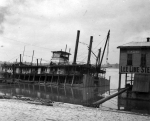K.M. Alexander's Blog, page 42
July 16, 2018
Raunch Reviews: Battlestar Galactica
Raunch Reviews is a series about profanity. Not real profanity, but speculative swearing. Authors often try to incorporate original, innovative forms of profanity into our own fantastical works as a way to expand the worlds we build. Sometimes we’re successful. Often we’re not. In this series, I examine the faux-profanity from various works of sci-fi and fantasy, judge their effectiveness, and rate them on an unscientific and purely subjective scale. This is Raunch Reviews, welcome.
[image error]The Authors: Glen A. Larson, Ronald D. Moore, David Eick
Work in Question: Battlestar Galactica (1978 & 2003)
The Profanity: “Frak”
As far as worldbuilding goes, Battlestar Galactica is a hodgepodge. It blends all manners of stuff: Ancient Greek gods, modern mythology, faster-than-light travel, politics, fear of the internet, murderous robots, weird visions, spaceship dogfights, strange paper with missing corners, and underwear worn over tee shirts. Yet despite its silliness, the 2003 reboot remained internally consistent and for a long time and—at least for its first two seasons—it was some of the best sci-fi on television. As a result, some of the silly points become charming, but sadly, “frak” isn’t one of them.
The word first appeared in the original series (1978) where it was initially spelled “frack” — it wasn’t until later (2003) that producers changed it to “frak” to make it a four-letter word. (Gasp!) It’s clear what it’s meant to replace, but it comes across more immature than serious. I dislike one-to-one replacement words, they’re lazy. There’s plenty of circumstances from the backstory that could have been effectively tapped for the purposes of faux-profanity. “Frak” is adolescent in tone, does little for the world, and effectively reads as an overt and clumsily minced-oath—nothing more than an attempt at sneaking naughty content past the censors. We all know what they were saying… well, except for KFC.
Score: [image error][image error][image error][image error][image error] (1.0)
Previous Raunch Reviews
“Jabber” from China Miéville’s Bas-Lag
“Storm it”/”Storms”/”Storming” from Brandon Sanderson’s The Stormlight Archives
Have a suggestion for Raunch Reviews? It can be any made up slang word from a book, television show, or movie. You can email me directly with your recommendation or leave a comment below. I’ll need to spend time with the property before I’ll feel confident reviewing it, so give me a little time. I have a lot of books to read.
[image error]
July 13, 2018
The Unread Story
“The unread story is not a story; it is little black marks on wood pulp. The reader, reading it, makes it live: a live thing, a story.”
A few years ago I helped back a beautiful little documentary on Le Guin’s life. If you haven’t seen it, I highly encourage you to seek it out. Le Guin was a fantastic writer and remains an inspiration not only to me but to a thousand other writers. You can view the trailer below.
[image error]
July 12, 2018
Garden of Horrors: Hydnellum Peckii
Sometimes nature is downright bizarre. Take the Hydnellum peckii, commonly called the “bleeding tooth fungus” (it’s also called “strawberries and cream” by people who, I assume, have never had strawberries or cream before.) When young the Hydnellum peckii produces a fluid that makes it look like a mushroom murder victim. It appears to “bleed” a red juice that in certain light looks an awful lot like blood. I’m not kidding, it’s kind of horrific.
[image error]A young Hydnellum peckii “bleeding”
The bright red fluid actually contains a pigment that is known to have anticoagulant properties, but it doesn’t stick around for very long. Once the fungus ages the “bleeding” stops and the Hydnellum peckii dries out and looks rather dull.
Despite its appearance, Hydnellum peckii is not poisonous, but the fungus is so bitter it’s considered inedible. Besides, why would you want to put this thing in your mouth anyway? That’s disgusting. Don’t be nasty.
 Want to stay in touch with me? Sign up for Dead Drop, my rare and elusive newsletter. Subscribers get news, previews, and notices on my books before anyone else delivered directly to their inbox. I work hard to make sure it’s not spammy and full of interesting and relevant information. SIGN UP TODAY →
Want to stay in touch with me? Sign up for Dead Drop, my rare and elusive newsletter. Subscribers get news, previews, and notices on my books before anyone else delivered directly to their inbox. I work hard to make sure it’s not spammy and full of interesting and relevant information. SIGN UP TODAY →
July 6, 2018
The Collection Grows
Last night, while pallin’ around at the Pioneer Square Art Walk, Kari-Lise and I checked out our friend Casey Weldon’s solo show at Treason Gallery. If you’re in Seattle, I recommend swinging through. It’s an incredible body of work, and a great selection of Casey’s engaging and often humorous work—check out the full show here.
It’s a big show, and there was a lot to check out, and much of the work drew us in. But we both fell in love with the green variant of Casey’s Fang You Very Much. Next week is our fifteen-year anniversary, so Kari-Lise and I figured this would be an excellent gift for ourselves—something collective and something we both appreciate. I’ve shared it below, it’s glorious.
[image error]Casey Weldon – Fang You Very Much – Green (2018) – Acrylic on wood – 12” x 12”
I really dig the visual depth going on here, the loose swirls and patterns offset by the realistic mouth, and the creepy glowing eyes. Casey’s skills and imagination never cease to impress me. The subtle reference to Felix the Cat is a nice touch, and something I initially missed (thank’s for pointing it out Julie.) I’m excited to hang it up in our home and finally add a Weldon to our collection. It’s about damn time.
June 29, 2018
Pay the Writer
Rest in peace, Harlan Ellison. You incredibly complex man, you.
I’ve seen many good folks sharing all sorts of stories about Ellison. Three that stuck out: John Scalzi’s piece for the LA Times, Neil Gaiman’s heartfelt blog post about their friendship, and this wild thread where Ellison publically plans a conspiracy to commit murder at Dragon Con. I’m sure there are many more.
If you are interested in reading Ellison’s work (there’s a reason he’s an SFWA Grand Master), I recommend starting with either I Have No Mouth, and I Must Scream or Repent, Harlequin!” Said the Ticktockman. He also wrote the greatest episode of Star Trek ever.
June 20, 2018
I’m in SPFBO 4
I’m excited to announce that my first novel, The Stars Were Right, has been accepted into this year’s Self-Publishing Fantasy Blog-Off. This will be my first book award contest since I started writing and I’m excited to be a part.
Here’s how it works: each year 300 fantasy authors submit their books. Those books are then divided among ten bloggers—Stars will be reviewed this year by the good folks over at Booknest. In Phase One, the books are read, and each blogger chooses one book to advance to the next round. Then in Phase Two all the bloggers read the submitted ten, and score each of them. Out of those ten books only one will be selected as the winner! It’s fun and great for the indie fantasy community. Check out the past winners here.
300 Books. 10 Judges. 1 Winner.
Big thanks to author Mark Lawrence for championing all of this, organizing events like this can be a lot of work, and Mark has been a tireless supporter of indie authors. Be sure to check out Mark’s books, follow him on Twitter, and read his blog.)
Also, I want to thank my pal Mihir from Fantasy Book Critic for letting me know submissions were open. I’ve watched the SPFBO from the sidelines for a few years now, and for whatever reason, I never thought my books qualified. I’m happy I listened to him and took the opportunity to submit.
Win or lose, I’m excited to see how The Stars Were Right does. The contest skews heavily towards fantasy fiction, and while The Stars Were Right is very much urban fantasy, the weird world of the Territories has a lot in common with many other subgenres. As my readers know, I tend to eschew the standard fantasy trappings in exchange for something more… um, strange. So, we’ll see! Fingers crossed!
Phase One runs from August 1st – December 31st, 2018. If you want to read along, you can see the full list and bloggers participating over here. Follow along on Twitter by using the hashtag #SPFBO. Regardless of the outcome, I’m excited to join in, and I want to wish good luck to everyone who is competing. It should be a good year!
June 18, 2018
Raunch Reviews: Bas-Lag
Raunch Reviews is a series about profanity. Not real profanity, but speculative swearing. Authors often try to incorporate original, innovative forms of profanity into our own fantastical works as a way to expand the worlds we build. Sometimes we’re successful. Often we’re not. In this series, I examine the faux-profanity from various works of sci-fi and fantasy, judge their effectiveness, and rate them on an unscientific and purely subjective scale. This is Raunch Reviews, welcome.
[image error]
The Author: China Miéville
Work in Question: The Bas-Lag Cycle
The Profanity: “Jabber”/ “By Jabber”/ “Jabber &^%!”
I’m going to be honest, I really like “Jabber.” The word comes from the Bas-Lagian pietist Saint Jabber who is apparently some sort of deity within the world. That makes this term a straightforward oath and easily accessible to most English speaking populations (where blasphemous oaths like this are commonplace). Plus there’s something that rolls off the tongue with “Jabber.” It’s easy to say, doesn’t need to be shortened, and feels natural when read. Likewise, it can be coupled with other vulgarities, therefore expanding its use. One slight mark against it, however, is the lack of any worshipers. Most of the characters in Miéville’s book aren’t the church-going type, but even among the background we don’t see much in the way of a Church of St. Jabber. There’s an area of slums in the city-state of New Crobuzon named St. Jabber’s Mound but otherwise, it’s fairly quiet. So while “Jabber” is grounded within in-world history—any real offense is lost on the reader.
Score: [image error][image error][image error][image error][image error] (4.0)

June 17, 2018
Everything is Becoming Science Fiction
“Everything is becoming science fiction. From the margins of an almost invisible literature has sprung the intact reality of the 20th century.”
I remember squabbling with a friend at fourteen over video games. I told him that someday every video game would be, at its core, a role-playing game. I argued that it was the natural evolution of the platform. (We didn’t use terms like “evolution” and “platform,” but you get the idea.) He disagreed. Here we are, decades later and everything from shooters to sports games to driving sims has role-playing elements. This quote from Ballard reminds me of that argument. As humanity continues to progress, what was once science fiction is now just modern life. The lines between science fiction and today’s reality have blurred. We’re seeing that blurring within fiction as well.
June 16, 2018
A Riverboat’s Demise
The lifespan of most riverboats was short. The swirling waters and strong currents in a river presented many dangers. Snags and other obstructions beneath the surface could easily punch a hole in a hull, sinking a boat. Weather could also play a factor. Fierce storms wreaked havoc and winter ice would routinely destroy steamboats.
[image error]Steamboat Accidents on the Western Rivers 1811-1851, taken from Steamboats on the Western Rivers , sourced from Cist’s Weekly Advertiser (Cincinnati), July 16, 1852
The natural world wasn’t the only danger. Packets were rarely inspected and with little governmental oversight, many became death traps. All were made of timber and powered by fire-heated boilers, deadly blazes and boiler explosions were common, and the loss of life and property could be catastrophic. Mark Twain’s younger brother Henry Clemens was killed in a boiler explosion on the steamer Pennsylvania in 1858, an event Twain details in Life on the Mississippi.
“A steamer came along, finally, and carried the unfortunates to Memphis, and there the most lavish assistance was at once forthcoming. By this time Henry was insensible. The physicians examined his injuries and saw that they were fatal, and naturally turned their main attention to patients who could be saved.”
—Mark Twain, Life on the Mississippi, Chapter 20, A Catastrophe
My current project, Coal Belly, is a sprawling weird-west fantasy adventure set on a planet crisscrossed by interlocking rivers. Riverboats are necessary and ubiquitous, and with their use comes the hazards of operation. A world of riverboats means a world of riverboat wrecks and having a working knowledge of their dangers went a long way toward adding a level of authenticity to my manuscript.
Those packets which survived weather, explosion, and accident rarely operated long. Most boats were worked hard and maintained poorly, and that it took its toll on their lifespan. While a well-maintained riverboat can last decades, most of the boats that operated in the late-1800s lasted between two to five years.
[image error]Left to Right: Fire takes the Str. Robert E. Lee killing 21 in 1882, a boiler explosion on the Str. Benjamin Franklin, 1836, The Sultana disaster claimed 1192 lives (perhaps up to 1800) outside Memphis, Tennessee in 1865, it remains one of the worst maritime disasters in United States history.
In the 1800s photographic equipment wasn’t as commonplace as it is today, and most of it wasn’t quick enough to capture riverboat disasters as they happened. In place of photographs, many tragedies were depicted by drawings or etchings. You can see a few above. Photographers, however, did manage to capture images of wrecked boats after they had been damaged, sunk, or destroyed. I’ve assembled a gallery below, you can click on any image to view it larger.



















The pictures above have been collected over the last five years, so I am unsure where they all come (usually the Library of Congress.) But, they’re all old enough to be in the public domain. In some cases, I did some minor color correction and cropping. I’m happy to answer any questions folks have about any of these images or riverboats in general. (Sometimes it gives me a good excuse to research something.) You can send me an email or leave a comment below. I love comments.
A Riverboat’s Demise is the latest in my series of posts sharing my research for Coal Belly. You can check out the other riverboat-related posts with the links below.
A Riverboat’s Pilothouse
Riverboats at War
A Riverboat’s Roustabouts
A Riverboat’s Menu
Riverboat Interiors
Riverboats & Levees
The Masonic Ironclad
 Want to stay in touch with me? Sign up for Dead Drop, my rare and elusive newsletter. Subscribers get news, previews, and notices on my books before anyone else delivered directly to their inbox. I work hard to make sure it’s not spammy and full of interesting and relevant information. SIGN UP TODAY →
Want to stay in touch with me? Sign up for Dead Drop, my rare and elusive newsletter. Subscribers get news, previews, and notices on my books before anyone else delivered directly to their inbox. I work hard to make sure it’s not spammy and full of interesting and relevant information. SIGN UP TODAY →
June 15, 2018
Visual Inspiration: Zhichao Cai
I’ve been ramping up my research for The Bell Forging Cycle, Book IV and while browsing through my Pinterest boards, I kept coming across the work of Chinese illustrator Zhichao Cai also known as Trylea. Since I found his work inspiring, I figured it’d be worth it to take a moment and share some of my favorite pieces with you.
When it comes to mood boards, I tend to like grimy and dank cityscapes occasionally interrupted with bright splashes of neon. So my eye is always drawn to pieces that show clusters of humanity. Trylea’s work has that, but it also differs significantly. It’s mainly due to his use of color. Even his densely packed cities are awash with a vibrancy that captures a unique and frenetic energy—it makes his work stand out, and his pieces serve as a good reminder that even in concept art we don’t need everything to be grim.
I included a small gallery of some of my favorite work below.







You can check out much more of Trylea’s work on his Zcool page, that seems to be where he shares most of his work. He also posts high-resolution versions as well as some process shots. It’s worth spending some time on his page. You can also find him on Behance, and he has some work on Art Station. If you’re not a member of any of those sites, I encourage you to join and give Trylea a follow.
If you like Zhichao Cai’s work be sure to check out some other illustrators and concept artists I’ve shared in the past:
Yuri Shwedoff
Jordan Grimmer
Kuldar Leement
Marc Simonetti
Anthony Wolff
Robin Olausson



